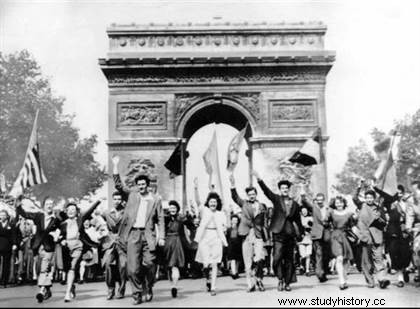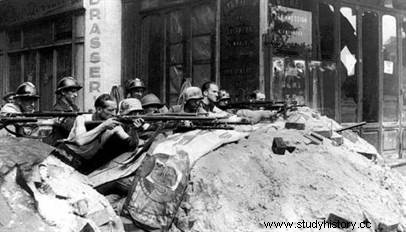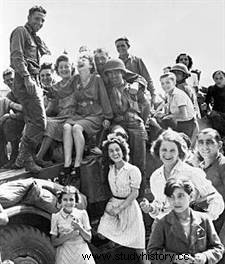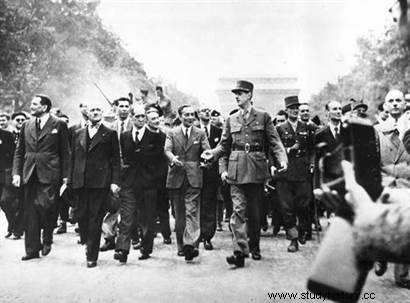 The liberation of Paris (August 19-25, 1944) was an insurrectionary movement that drove the German occupiers out of the capital at the end of World War II. It was recorded on August 25, 1944 at Montparnasse station by General Dietrich Von Choltitz who signs the act of surrender of the German troops, in the presence of General Leclerc and Colonel Rol-Tanguy . It was the end of an occupation that began on June 14, 1940. Carried out in an electric atmosphere, marked by confusion on both the Allied and German sides, the liberation of Pari s constitutes in many respects a summary of the political and military stakes of the second French campaign. Adventure magnified by the famous “Is Paris burning? by Collins and Lapierre, this event holds a very special place in the contemporary mythology of French history.
The liberation of Paris (August 19-25, 1944) was an insurrectionary movement that drove the German occupiers out of the capital at the end of World War II. It was recorded on August 25, 1944 at Montparnasse station by General Dietrich Von Choltitz who signs the act of surrender of the German troops, in the presence of General Leclerc and Colonel Rol-Tanguy . It was the end of an occupation that began on June 14, 1940. Carried out in an electric atmosphere, marked by confusion on both the Allied and German sides, the liberation of Pari s constitutes in many respects a summary of the political and military stakes of the second French campaign. Adventure magnified by the famous “Is Paris burning? by Collins and Lapierre, this event holds a very special place in the contemporary mythology of French history.
Should we fight for the liberation of Paris?
In mid-August 1944, Allied troops engaged in France were still fighting in and around the famous "Poche de Falaise ". It is in this cauldron that most of the German forces resisted, which until then had fiercely defended Normandy (5 e Armored Army and part of the 7 th army). The 21 th (General Montgomery, 2nd British Army, 1st Canadian Army) and 12 th (General Bradley, 1st Army and 3rd US Army) groups of Allied armies threw considerable forces into battle (approximately 3,500 armored vehicles). Nevertheless, at the high command, caution remained in order, due to the German tactical superiority and the desire to limit losses. As a result, the Battle of Falaise did not lead to a new Stalingrad and many German units managed to get out of the pocket (never completely closed until the 21st) at the cost of abandoning equipment. Anyway it seems that a quick end to the world war in the west is possible, the Wehrmacht theoretically not having much more to oppose to the mechanical mass of the allies.
With this in mind, the question arises of how to exploit this victory and especially in which direction? Opinions differ, but it seems obvious to General Eisenhower (Supreme Commander of the Allied Expeditionary Forces), that exploitation must not result in a rush to Paris. True to his convictions, the American general considers that it would be too costly to engage in difficult street battles and thinks of obtaining the surrender of the city by surrounding it.
This strategy hardly meets General de Gaulle's expectations. The leader of Free France had long foreseen that the liberation of Paris would be carried out by a large French unit. He believes that this will allow him to assert the legitimacy of Free France against the allies. The large unit of his choice is the 2 th Armored Division of General Leclerc. A choice that explains why this division was the only French unit engaged in Normandy. From August 2 it took part in the fighting against several German panzer-divisions, reached Argentan and was in a position to advance rapidly towards the capital.

The uprising of inner resistance
In Paris the German troops who could defeat Lerclerc have recently been led by Dietrich Von Choltitz. This veteran general of the eastern front, has under his command (the Gross Paris) 20,000 men, from heterogeneous units. In particular, support formations (even administrative) and Waffen SS intersect there. The equipment is also uneven, about 80 armored vehicles:from French recovery tanks to the most modern Panzers (Panthers) as well as decent artillery. Choltitz received (repeatedly) Hitler's order to turn Paris into a field of ruins to facilitate its defense. He will refuse, certainly on the advice of the influential Swedish consul Raoul Nordling, but also for fear of a general uprising of Parisians.
The Parisian resistance has been chomping at the bit since the announcement of the landing. She is seriously considering taking action. To lead the insurrection, two men:Henry Tanguy (Colonel Rol-Tanguy) former international brigades, essential figure of the FTP, at the head of the Parisian FFI and the delegate of General de Gaulle Jacques Delmas (Chaban Delmas), high official and agent of Free France. If Chaban and Rol collaborate closely, they are nonetheless subject to the hidden rivalries that oppose Communists and Gaullists. Coordinating the action of very diverse cells from its underground PC (under the place Denfert-Rochereau in the 14 e district), Rol-Tanguy decides to overtake the Germans. In doing so, he hastened events (perhaps spurred on by the PCF?), overestimating the speed of progress of the allies (which can be explained by the difficulty of liaison with them).
 From the 13th the insurrection took shape (first the metro staff, then the gendarmes and finally the police) before becoming a general strike on August 18. Paris revives its long tradition of barricades and the first serious skirmishes take place with German units, supported by the Militia. On August 19, the resistance fighters occupied town halls, ministries and the police headquarters.
From the 13th the insurrection took shape (first the metro staff, then the gendarmes and finally the police) before becoming a general strike on August 18. Paris revives its long tradition of barricades and the first serious skirmishes take place with German units, supported by the Militia. On August 19, the resistance fighters occupied town halls, ministries and the police headquarters.
From the 20th, the clashes redoubled in intensity, the Germans counter-attacking especially around the police headquarters. Although a truce has been negotiated, the fighting continues and will reach its peak intensity on the 22nd. Could the Parisian resistance then know the fate of the Polish Home Army, crushed at the same time in Warsaw by the Nazis?
The ride of the 2 e DB and the liberation of Paris
2 days earlier, Leclerc stopped near Argentan, decided to launch a sounding on the sly towards Paris. He sent in his direction a detachment comprising about twenty armored vehicles (10 light tanks, 10 armored cars) and 150 men. This recognition, although endorsed by De Gaulle, was condemned by the Americans and Leclerc had to explain it to Bradley in Laval on the 22nd. That afternoon, the American general was absent, but Leclerc met the chief of staff from Rol Tanguy (the Welsh commander) who informed him of the critical situation of the FFI. When Bradley shows up at the start of the evening, it is with relief that Leclerc and Gallois learn that Eisenhower has agreed to launch the 2nd DB towards Paris. De Gaulle threw all his weight to obtain the consent of the Allied command, Paris will be liberated by a French unit!
 The Leclerc division (supported by the 4
e
DI US) must seize the capital for the 24th. It consists of three tank regiments, supported by tank destroyers, mechanized infantry and artillery (in all 16,000 men, 160 Sherman tanks) . Although of heterogeneous recruitment (free French, former members of the African army) it enjoys a strong esprit de corps maintained by its charismatic commander. Galvanized by the historical importance of their mission, his soldiers will achieve a feat by covering more than 200 km in two days (knowing that during its progression the whole of the division is spread over more than a hundred kilometers…). On the evening of the 23rd they arrived in the Rambouillet region.
The Leclerc division (supported by the 4
e
DI US) must seize the capital for the 24th. It consists of three tank regiments, supported by tank destroyers, mechanized infantry and artillery (in all 16,000 men, 160 Sherman tanks) . Although of heterogeneous recruitment (free French, former members of the African army) it enjoys a strong esprit de corps maintained by its charismatic commander. Galvanized by the historical importance of their mission, his soldiers will achieve a feat by covering more than 200 km in two days (knowing that during its progression the whole of the division is spread over more than a hundred kilometers…). On the evening of the 23rd they arrived in the Rambouillet region.
Leclerc has divided his unit into four battle groups (GTD, GTL, GTV, GTR), two will have to participate directly in the capture of the city (GTV, GTL), the two others being held in reserve. Leclerc is in a hurry because he knows that Choltitz must receive reinforcements shortly. On August 24, 1944, he launched the two Groups to attack Paris, both having the Place de la Concorde as their common objective. They will immediately come up against the defenses in the south of the capital, reinforced by strongpoints built around anti-tank guns (88mm). Nevertheless, the Chad marching regiment headed by the 9 e company of Captain Dronne ended up infiltrating by bypassing these defenses. At 8:45 p.m. he entered Paris through the Porte d'Italie and reached the town hall less than an hour later. Very quickly the cooperation with the FFI is organized and gives hope to the almost defeated resistance fighters.
The next day the fight for the capital reaches its climax. The action of the 2 e DB, is hampered by the resistance of the Germans around several strategic buildings (the Military School, the Luxembourg, the Chamber of Deputies), but also by the popular enthusiasm of the Parisians who do not always measure the gravity of the situation. This day will indeed be bloody, both for the FFI and Leclerc's men and for the civilians. Choltitz nevertheless understands that the battle is already lost and refusing one last time to carry out Hitler's orders, decides to surrender his troops. After a last stand in his HQ at the Hôtel Meurice, he left to sign the act of surrender in the presence of Leclerc and Rol-Tanguy.
Paris broken! Paris martyred! But Paris liberated!
General de Gaulle arrived in Paris on the evening of the 25th. On August 26, he performed one of his most symbolic gestures of the conflict, rekindling the flame of the unknown soldier on which the tricolor flag floats again then descending the Champs-Elysées alongside Leclerc. This gigantic parade, so often immortalized by the image, will nevertheless be disturbed by the gunfire of the attacks of snipers. Indeed the fighting will not completely cease until the 28th.
 The liberation of Paris, a highly political undertaking, will have had its human cost, a substantial cost. 630 men for the 2
th
DB, 500 for the FFI, more than 900 civilians and thousands of wounded. The Germans will have lost 15,000 men (3,200 killed). Nevertheless, the objective of Free France, namely the liberation of its capital by a French unit, will have been achieved. General de Gaulle will find there a powerful factor of legitimacy for his GPRF, in the face of the Allied powers who had initially planned to impose an Anglo-Saxon military administration (AMGOT) on France.
The liberation of Paris, a highly political undertaking, will have had its human cost, a substantial cost. 630 men for the 2
th
DB, 500 for the FFI, more than 900 civilians and thousands of wounded. The Germans will have lost 15,000 men (3,200 killed). Nevertheless, the objective of Free France, namely the liberation of its capital by a French unit, will have been achieved. General de Gaulle will find there a powerful factor of legitimacy for his GPRF, in the face of the Allied powers who had initially planned to impose an Anglo-Saxon military administration (AMGOT) on France.
This will be the whole tenor of his famous speech at City Hall on August 25:“Paris! Paris outraged! Paris broken! Paris martyred! but Paris liberated! liberated by itself, liberated by its people with the help of the armies of France, with the support and the help of all of France, of France which is fighting, of France alone, of the real France, of eternal France. France returns to Paris, to her home. She returns bloody, but well resolved. She returns there, enlightened by the immense lesson, but more certain than ever, of her duties and her rights . »
Bibliography
- The Liberation of Paris:August 19-26, 1944, by Jean-François Muracciole. tallandier, 2013.
- Paris 1944, the stakes of the Liberation of Paris. Albin michel, 1994.
- Paris brule t'il, the epic of the liberation of Paris, by Dominique Lapierre and Larry Collins. Pocket, 2001.
